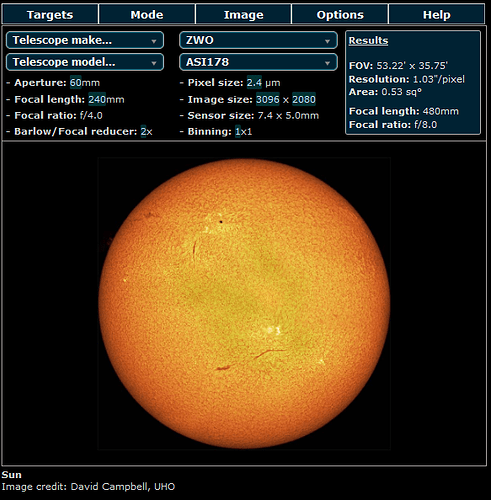Last night at CRO, Andy and I spent some time talking about imaging the upcoming April 8th solar eclipse. I spent most of the time extolling the virtues of SharpCap, the app that I will be running on my Windows laptop to control my ZWO camera and Celestron CGEM mount. One SharpCap feature we discussed in particular is a relatively new tool called “feature tracking.”
Feature tracking lets SharpCap use your connected ASCOM mount to guide the telescope and track on-screen image features like the solar disk. It works much like PHD2, which guides on stars, but instead uses the center of mass of a disk-shaped object like the Sun, Moon, or planet to guide the mount to keep the object centered. This guiding can be done using the imaging camera and scope, or using a separate finder scope and camera.
The developer states that this feature is not intended to provide “pixel perfect” guiding, but instead is just intended to keep the target object from drifting to the edges of the field of view. I’ve been testing feature tracking on the Sun, and in my estimation, it works very well in preventing significant drift and does much better than just keeping the Sun within the field of view.
Feature tracking is only available in SharpCap Pro (~ $15.00 per year), not the basic free version.
The screenshot below shows the feature tracking window while I was imaging and guiding on the Sun recently on a very windy day. Despite showing quite a bit of movement (caused by the wind), SharpCap kept the Sun well-centered in the field of view with very little drift throughout the session.
Andy also mentioned, and I wholeheartedly agree, that during the eclipse, your mount should be set on the solar tracking rate, not the usual sidereal rate for tracking stars. SharpCap allows you to select this tracking rate as shown in the screenshot below (along with some other useful items).
One brand new feature of SharpCap that might be of interest, and possible use, during the eclipse is its lunar, solar, and planetary live stacking mode. In this mode, you can capture, live stack, and apply wavelet sharpening and other enhancements in real time right at the scope. And, the resulting images can be saved manually individually, or automatically in a time lapse mode. The screenshot below shows a recent 50-frame live stack of the Sun with a very small touch of wavelet sharpening.
Finally, just one last comment. I’ve seen a lot of solar images lately where the Sun’s central region is blown out bright. I’ve found that with my rig, manipulating the exposure, gain, blue and red balance to keep the max luminance (white) histogram at or below 60%, and max color (e.g., red) histogram at or below 80% prevents this. The screenshot below shows the histogram shape that I will be dialing in for the partial phases of the eclipse to get a pleasing color balance that is not blown out bright toward the interior of the solar disk.








